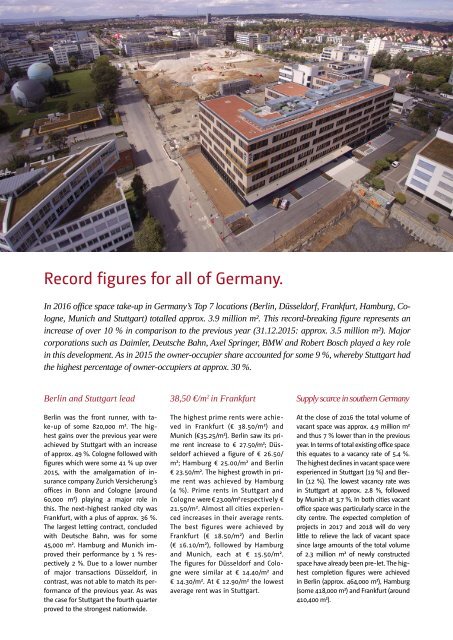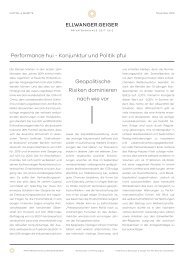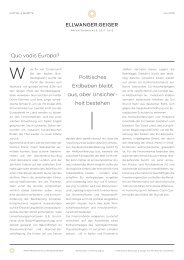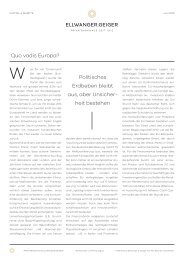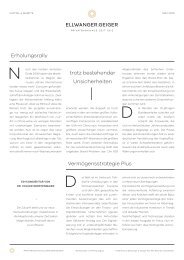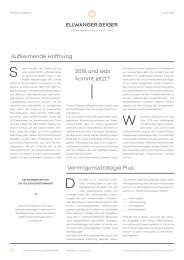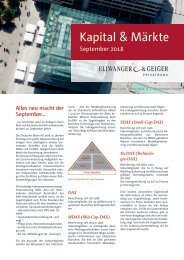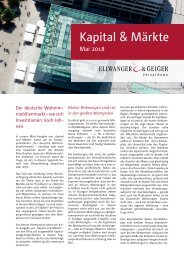The 2016/2017 Stuttgart office market report
Again in 2016 the Stuttgart office market reached new record levels. The turnover of floor space came to 432,000 square metres for the year, a growth of almost 50 percent. At the same time rents rose slightly, and the vacancy ratio fell by 2.8 percent. As in past years, the main growth driver was industry, but the IT and telecommunication sectors have also been responsible for increasing demand.
Again in 2016 the Stuttgart office market reached new record levels. The turnover of floor space came to 432,000 square metres for the year, a growth of almost 50 percent. At the same time rents rose slightly, and the vacancy ratio fell by 2.8 percent. As in past years, the main growth driver was industry, but the IT and telecommunication sectors have also been responsible for increasing demand.
You also want an ePaper? Increase the reach of your titles
YUMPU automatically turns print PDFs into web optimized ePapers that Google loves.
Record figures for all of Germany.<br />
In <strong>2016</strong> <strong>office</strong> space take-up in Germany’s Top 7 locations (Berlin, Düsseldorf, Frankfurt, Hamburg, Cologne,<br />
Munich and <strong>Stuttgart</strong>) totalled approx. 3.9 million m². This record-breaking figure represents an<br />
increase of over 10 % in comparison to the previous year (31.12.2015: approx. 3.5 million m²). Major<br />
corporations such as Daimler, Deutsche Bahn, Axel Springer, BMW and Robert Bosch played a key role<br />
in this development. As in 2015 the owner-occupier share accounted for some 9 %, whereby <strong>Stuttgart</strong> had<br />
the highest percentage of owner-occupiers at approx. 30 %.<br />
Berlin and <strong>Stuttgart</strong> lead<br />
Berlin was the front runner, with take-up<br />
of some 820,000 m². <strong>The</strong> highest<br />
gains over the previous year were<br />
achieved by <strong>Stuttgart</strong> with an increase<br />
of approx. 49 %. Cologne followed with<br />
figures which were some 41 % up over<br />
2015, with the amalgamation of insurance<br />
company Zurich Versicherung’s<br />
<strong>office</strong>s in Bonn and Cologne (around<br />
60,000 m²) playing a major role in<br />
this. <strong>The</strong> next-highest ranked city was<br />
Frankfurt, with a plus of approx. 36 %.<br />
<strong>The</strong> largest letting contract, concluded<br />
with Deutsche Bahn, was for some<br />
45,000 m². Hamburg and Munich improved<br />
their performance by 1 % respectively<br />
2 %. Due to a lower number<br />
of major transactions Düsseldorf, in<br />
contrast, was not able to match its performance<br />
of the previous year. As was<br />
the case for <strong>Stuttgart</strong> the fourth quarter<br />
proved to the strongest nationwide.<br />
38,50 €/m 2 in Frankfurt<br />
<strong>The</strong> highest prime rents were achieved<br />
in Frankfurt (€ 38.50/m²) and<br />
Munich (€35.25/m²). Berlin saw its prime<br />
rent increase to € 27.50/m²; Düsseldorf<br />
achieved a figure of € 26.50/<br />
m²; Hamburg € 25.00/m² and Berlin<br />
€ 23.50/m². <strong>The</strong> highest growth in prime<br />
rent was achieved by Hamburg<br />
(4 %). Prime rents in <strong>Stuttgart</strong> and<br />
Cologne were € 23.00/m² respectively €<br />
21.50/m². Almost all cities experienced<br />
increases in their average rents.<br />
<strong>The</strong> best figures were achieved by<br />
Frankfurt (€ 18.50/m²) and Berlin<br />
(€ 16.10/m²), followed by Hamburg<br />
and Munich, each at € 15.50/m².<br />
<strong>The</strong> figures for Düsseldorf and Cologne<br />
were similar at € 14.40/m² and<br />
€ 14.30/m². At € 12.90/m² the lowest<br />
average rent was in <strong>Stuttgart</strong>.<br />
Supply scarce in southern Germany<br />
At the close of <strong>2016</strong> the total volume of<br />
vacant space was approx. 4.9 million m²<br />
and thus 7 % lower than in the previous<br />
year. In terms of total existing <strong>office</strong> space<br />
this equates to a vacancy rate of 5.4 %.<br />
<strong>The</strong> highest declines in vacant space were<br />
experienced in <strong>Stuttgart</strong> (19 %) and Berlin<br />
(12 %). <strong>The</strong> lowest vacancy rate was<br />
in <strong>Stuttgart</strong> at approx. 2.8 %, followed<br />
by Munich at 3.7 %. In both cities vacant<br />
<strong>office</strong> space was particularly scarce in the<br />
city centre. <strong>The</strong> expected completion of<br />
projects in <strong>2017</strong> and 2018 will do very<br />
little to relieve the lack of vacant space<br />
since large amounts of the total volume<br />
of 2.3 million m² of newly constructed<br />
space have already been pre-let. <strong>The</strong> highest<br />
completion figures were achieved<br />
in Berlin (approx. 464,000 m²), Hamburg<br />
(some 418,000 m²) and Frankfurt (around<br />
410,400 m²).


